Hello there..
Pada postingan kali ini saya akan membagikan 5 contoh descriptive text tentang tempat - tempat tujuan wisata di Indonesia. Semoga bisa jadi referensi buat kamu yang sedang belajar Bahasa Inggris.
Happy reading and happy learning!!
1. Harau Valley
Harau valley is
a canyon near the town of Payakumbuh, Limapuluh Koto regency, West Sumatra
province. Harau valley flanked by steep rocky hills with height of 150 meters.
Harau valley is also surrounded by steep colorful sandstone, with height
of 100 to 500 meters. Harau Valley or sometimes called the Arau valley is
the place where lush green ricefields are hemmed in between huge granite
cliffs. There are dozens of waterfalls tumble down from 80 to 300 meters height
into the valley below, cutting by the Batang Arau River. No wonder, that the
Harau Valley is sometimes known as the Yosemite of Indonesia
Gibbons and Macaques and variety of wildlife is still
roam freely as this area in the Lima Puluh Kota district that has actually been
designated a nature conservation, covering some 669 acres. This place is truly
has beautiful landscape, peaceful serenity that only interrupted by the calls
of the macaques and the chirping birds.
There is waterfall named the Bunta Waterfall or locally called Sarasah
Bunta that pours down fresh water from the highlands with three other
waterfalls nearby. It was first visited in 1926 by a Dutch mayor. A carved
stone indicating the year when the mayor visited the waterfall is still there
expressing the beauty of this valley. Other waterfalls are called the Akar
Barayun, Sarasah Luluh, and Sarasah Murai.
The most direct way to reach Harau from Bukittinggi is by renting a
motorbike or taking an ojek for two hours. Alternatively, take a Po Sarah
Group minibus from the bus terminal to Tanjung Pati and then take an ojek the
rest of the way. Walking towards the Harau valley is very pleasant, with fresh
air and genuine sightseeing of surroundings. The granite cliffs towering with a
unique shape surrounding the valley will also pampering your sight. Those steep
granite cliffs have height for about 80 m to 300 m. From the start we entering
Harau Valley, we will find a lot of spectacular beauty along the way.
2. Nusa Dua
(image indonesiatravel.com)
Bali's most prestigious resort area, Nusa Dua is where
the tourists will find international world, class luxury hotels elegantly
lining beautiful white sands. Located on the Bukit peninsula, in the southern
part of Bali, approximately 10 km from the international airport. It is quiet
and exclusive with superb facilities.
Crystal clear water and stretches of white sandy beach of Nusa Dua makes
Nusa Dua a perfect spot for luxurious resorts to which exhausted the bodies,
after a Barong performance at Batubulan and a long climb of the steps of the
Mother Temple Besakih, will want to rest. Some of the most sumptuous and
luxurious hotels in the world find their home in Nusa Dua Bali. We can tee off
into the sunset, while watching the gentle waves come from the blue sea and
caress the banks surrounding the luscious greens. Tranquil swimming pools under
the coconut trees seem to be one with the distant blue sea. Art galleries and
numerous shops surround them.
Nusa Dua is really about taking it easy and relaxing in total luxury. As
most of the hotels are 5 stars, every comfort is at our disposal as well as a
gorgeous white sand beach. Nusa Dua was designed for the luxury conscious with
a heavy concentration of big name hotels lining the beautiful white sand beach.
The kind of activities on offer gives a flavor of Nusa Dua. The Bali Golf and
Country Club, an immaculately landscaped 18 holes ocean view course. The Bali
International Lawn Tennis & Lawn Bowls Club next to the Galleria Nusa Dua a
spacious shopping mall with boutiques and up market restaurants. Close by
Chandra Koka Amphitheatre provides a venue for traditional entertainment
including arts festivals like the Nusa Dua Arts and Culture Festival. Stroll to
the northern end of Nusa Dua for parasailing, jet skis, snorkeling/diving trips
or better still, head for Tanjung Benoa.
Some of the resorts have private beaches but most areas are accessible.
The stretch past the Hilton Resort has been a public beach and during the wet
season, the outer reef there is a popular surf break. At present we will find
some simple warungs selling good food at cheap prices along this beautiful
stretch of white sandy beach that offers excellent swimming conditions in a
protected lagoon
Penyengat
Island, otherwise locally known as Penyengat Indera Sakti, is only a short
15-minute motorised boat trip off the coast of Bintan's capital Tanjung Pinang.
It’s rich in history, being the cradle of the Riau-Johor sultanate some
centuries back and with remnants of the Malay Empire’s illustrious past spread
throughout the island. One of the iconic landmarks, the Grand Mosque of the
Riau Sultanate, or Masjid Raya Sultan Riau, stands tall near the harbour,
welcoming visitors approaching on boats.
This tiny 200Ha island is also home to Kompleks Makam Raja-Raja, or the ‘tombs of the sultans’, a common stopover that follows on after a visit to Masjid Raya. The main tomb of Engku Putri Raja Hamidah, the wife of sultan Mahmud Syah of Malacca and ruler of Penyengat at the time, has walls all painted in yellow, just like the Grand Mosque. Other tombs surrounding it include that of Raja Ali Haji, a national hero who wrote the oldest publication on Malay grammar, as well as an extensive body of Malay poetry known as Gurindam Dua Belas.
The
best way to go around is by motorcycle taxi, with unofficial fares anywhere
between IDR 30,000-50,000 for a day trip. This is also due to the streets on
the island dominated by bikes and motorcycles – they are too narrow for cars.
Being a frequent stopover for many centuries by seafarers and fishermen from
all over the Southeast Asian region and Indonesia alone, particularly the
seafaring Bugis tribes of southern Sulawesi, you’ll encounter many Bugis
fishing villages around the coasts.
Up on the hills of Penyengat Island, there are several historical forts such as Bukit Kursi, which features a vantage point over the open sea. Although the abandoned fort now sits in ruins, you can still go around and find several old cannons lying about. For the culturally inclined, head to the Balai Adat Melayu Riau where you can admire replicas of traditional stilt houses, with life-sized dioramas and other Malay-Riau related cultural objects inside. A tour to Penyengat offers great insight into the history of the region, and the best thing about touring the small island is that it usually doesn’t take a full day.
(adapted from http://www.indonesia-holidays.com)
Wakatobi hangs off the bottom of Sulawesi’s
south eastern peninsular; a dazzling archipelago of 143 tropical islands
sitting resplendently among a 1.4 million hectare marine wonderland. “Paradise
on earth” is a tag so commonly applied to Wakatobi it’s almost cliché but
anything less complementary would be churlish.
Wakatobi
sits right in the heart of the so-called Asia-Pacific Coral Triangle. Its warm
clear waters provide such a perfect habitat for coral that nearly 90% of the
world’s known coral dwelling species are found within is boundaries. No less
than 25 separate fringing, atoll and barrier reef systems are teaming with a
stunning array of colourful corals, fish and other exotic marine creatures
whllst whales, dolphins, manta-rays and turtles are equally prevalent. Over 50
dive sites provide abundant diving opportunities but with many shallow reef
systems and excellent visibility, snorkelling is just as rewarding.
The
islands are just as pretty; low lying sandy isles and atolls crowned with
tropical jungle, mangrove forests and white sandy beaches fringed with swaying
palms. Of the 143 islands, only 7 are inhabited, predominantly by ethnic Bajo
sea gypsy communties who have moved among the islands for centuries.
Traditionally known as the Tukang Besi Islands, the popularly adopted name
Wakatobi is actually an ancronym for the four largest islands, from north to
south – Wangi-wangi (WA), Kaledupa (KA), Tomia (TO) and Binongko (BI). The
largest settlement, Wanci on Wangi-Wangi Island is the Wakatobi capital but
it’s far from busy. Like the rest of the archipelago, it has a languid chilled
out vibe that makes doing anything other that hanging out in a hammock in
between snorkelling and diving trips seem downright excessive.
(adapted from http://www.roamindonesia.com/)5. Komodo National Park
(image from indonesiatravel.com)
Komodo
Island or Komodo National Park is The World Heritage Site Komodo is one
of the 17.508 islands That make up the Republic of Indonesia. The island has a
surface area of 390 km ² and over 2000 inhabitants. Komodo is part of the
Lesser Sunda chain of islands and forms part of the Komodo National Park.
Particularly Notable here is the native Komodo dragon. In Addition, the island
is a popular destination for diving. Administratively, it is part of the East
Nusa Tenggara province.
Komodo
Island or Komodo National Park is home to the world's largest lizard. Komodo is
the largest lizard in the world, As an Indonesia Endemic animals, they just
stay on the island of Komodo, Rinca island and small islands around it, and in
the western part of Flores Island in Indonesia. There are 277 species of
animals which is a mix of animals coming from Asia and Australia, which
consists of 32 species of mammals, 128 species of birds and 37 species of
reptiles. Together with dragons, at least 25 species of land animals and birds,
including protected animals, because the amount is limited, or limited their
deployment.
Komodo National Park includes one of the world's richest marine environments. It consists of forams, cnidaria (includes over 260 species of reef building coral), sponges (70 species), ascidians, marine worms, mollusks, echinoderms, crustaceans, cartilaginous and bony fishes (over 1,000 species), marine reptiles, and marine mammals (dolphins, whales, and dugongs). Some notable species with high commercial value include sea cucumbers, Napoleon wrasse, and groupers. Some of the Komodo's sandy beach beautiful pink, colored by fragments of red coral mixed with other shell and coral fragments. Other beach has gray sand derived from rhyolite cliffs. Heavy black sand consists of nearly pure magnetite accumulates on the side of the cliff
Komodo National Park includes one of the world's richest marine environments. It consists of forams, cnidaria (includes over 260 species of reef building coral), sponges (70 species), ascidians, marine worms, mollusks, echinoderms, crustaceans, cartilaginous and bony fishes (over 1,000 species), marine reptiles, and marine mammals (dolphins, whales, and dugongs). Some notable species with high commercial value include sea cucumbers, Napoleon wrasse, and groupers. Some of the Komodo's sandy beach beautiful pink, colored by fragments of red coral mixed with other shell and coral fragments. Other beach has gray sand derived from rhyolite cliffs. Heavy black sand consists of nearly pure magnetite accumulates on the side of the cliff
(adapted from https://www.indonesia-tourism.com)

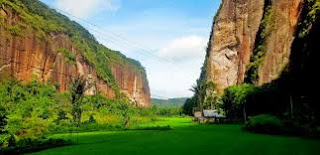
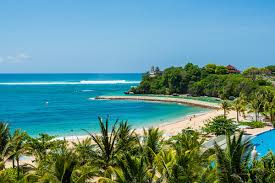
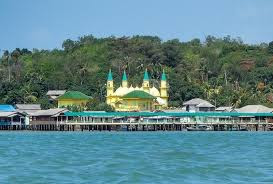
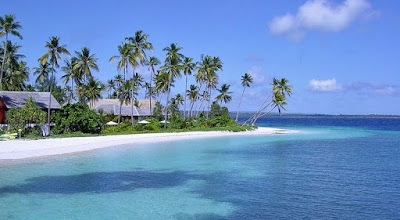
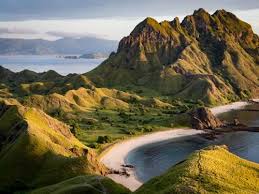

1 Comments:
Terjemahannya dong
Post a Comment